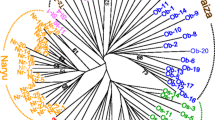Abstract
Polymorphic simple sequence repeat (SSR) markers of Ecklonia radicosa were developed using Illumina MiSeq next-generation sequencing (NGS) analysis. In total, 3112 SSRs (di- to hexanucleotide motifs repeated more than six times) were identified from 61.5-Mb assembled genomic DNA using MISA perl script. Among the SSRs, di- (853 loci, 27.4%) and trinucleotides (1813 loci, 58.3%) were dominant, while tetra- (172 loci, 5.5%), penta- (175 loci, 5.6%), and hexanucleotides (99 loci, 3.2%) were not common. After specific amplification and polymorphic tests of 75 selected loci (tri- to hexanucleotide motifs repeated more than eight times), 11 SSR markers (Eradic01–11) were successfully developed. The range of the number of alleles, observed heterozygosity, and expected heterozygosity in the 11 markers was 3–13, 0.200–0.683, and 0.258–0.864, respectively. Polymorphic information content (PIC) analysis indicated that eight markers (Eradic01, 02, 04, 05, 06, 08, 09, and 11) were highly informative (PIC > 0.5) and the other three were reasonably informative (0.5 < PIC < 0.25). In addition, intra-genus amplification was obtained in all markers except for Eradic02, 08, and 11. These markers could help to reveal the genetic diversity and population structure of E. radicosa.
Similar content being viewed by others
References
Akita S, Yamada H, Ito M, Kobayashi M Fujita D (2014) Phenology of annual kelp Eckloniopsis (Phaeophyceae, Laminariales) forest on a Diadema barren in Uchiura Bay, Central Pacific Coast of Honshu, Japan. J Appl Phycol 26:1141–1148
Akita S, Yamada H, Ito M, Graham MH, Fujita D (2016) Sorus formation on the holdfast haptera of the kelp Ecklonia radicosa (Phaeophyceae, Laminariales). Bot Mar 59:433–438
Botstein D, White RL, Skolnick M, Davis RW (1980) Construction of genetic linkage map in man using restriction fragment length polymorphisms. Am J Hum Genet 32:314–331
Coleman MA (2013) Connectivity of the habitat-forming kelp, Ecklonia radiata within and among estuaries and open coast. PLoS One 8(5):e64667
Coleman MA, Connell SD, Gillanders BM (2009) Dispersal and gene flow in the habitat-forming kelp, Ecklonia radiata throughout South Australia. Mar Freshw Res 60:802–809
Coleman MA, Chambers J, Knott N, Malcolm H, Harasti D, Jordan A, Kelaher BP (2011a) Connectivity within and among a network of temperate marine reserves. PLoS One 6:e20168
Coleman MA, Roughan M, McDonald H, Connell SD, Gillanders BM, Kelaher BP, Steinberg PD (2011b) Variation in the strength of continental boundary currents determines patterns of large-scale connectivity in kelp. J Ecol 99:1026–1032
Dolman G, Coleman MA (2009) Characterisation of microsatellite loci in the habitat-forming kelp, Ecklonia radiata (Phaeophyceae, Laminariales). Conserv Genet 10:657–660
Doyle JJ, Doyle JL (1990) Isolation of plant DNA from fresh tissue. Focus 12:13–15
Guichoux E, Lagache L, Wagner S, Chaumeil P, Léger P, Lepais O, Lepoittevin C, Malausa T, Revardel E, Salin F, Petit RJ (2011) Current trends in microsatellite genotyping. Mol Ecol Res 11:591–611
Itou T, Kanno M, Suyama Y, Kamiyama A, Sakamoto XS, Kijima A, Inaba K, Aoki NM (2006) Development of 12 polymorphic microsatellite DNA markers for the kelp Ecklonia cava (Phaeophyceae, Laminariales). Conserv Genet Resour 4:459–461
Komazawa I, Sugino T, Takino K, Ando K, Yokohama Y (2006) Growth and maturation of the brown alga Eckloniopsis radicosa, on the coast of Izu-Oshima Island, central Japan. Aquacult Sci 54:489–494 (in Japanese with English abstract)
Komazawa I, Sakanishi Y, Tanaka J (2015) Temperature requirements for growth and maturation of the warm temperate kelp Eckloniopsis radicosa (Laminariales, Phaeophyta). Phycol Res 63:64–71
Maeda T, Kawai T, Nakaoka M, Yotsukura N (2013) Effective DNA extraction method for fragment analysis using capillary sequencer of the kelp, Saccharina. J Appl Phycol 25:337–347
Marshall TC, Slate J, Kruuk LEB, Pemberton JM (1998) Statistical confidence for likelihood-based paternity inference in natural populations. Mol Ecol 7:639–655
Rousset F (2008) Genepop’007: a complete reimplementation of the Genepop software for Windows and Linux. Mol Ecol Resour 8(1):103–106
Rozen S, Skaletsky HJ (2000) Primer3 on the WWW for general users and for biologist programmers. In: Krawetz S, Misener S (eds) Bioinformatics methods and protocols: methods in molecular biology. Humana Press, Totowa, pp 365–386
Terada R (2011) A review of long-term survey of seaweed/seagrass communities in Japan. Aqua 33:279–291 (In Japanese with English abstract)
Terada R, Shikada S, Watanabe Y, Nakazaki Y, Matsumoto K, Konozo J, Saino N, Nishihara GN (2016) Effect of PAR and temperature on the photosynthesis of the Japanese alga, Ecklonia radicosa (Laminariales), based on field and laboratory measurements. Phycologia 55:178–186
Thiel T, Michalek W, Varshney RK, Graner A (2003) Exploiting EST databases for the development and characterization of gene-derived SSRs-markers in barley (Hordeum vulgare L.) Theor Appl Genet 106:411–422
Tsutsui I, Ohno M (1993) Growth and maturation of Undaria pinnatifida, U. undarioides and Eckloniopsis radicosa at Susaki Bay of Kochi in Japan. Aquacult Sci 41:55–60 (in Japanese with English abstract)
Uchino T, Nakamura Y, Sekino M, Kai W, Fujiwara A, Yasuike M, Sugaya T, Fukuda H, Sano M, Sakamoto T (2016) Constructing genetic linkage maps using the whole genome sequence of Pacific bluefin tuna (Thunnus orientalis) and a comparison of chromosome structure among teleost species. ABB 7(02):85–122
Van Oosterhout C, Hutchinson WF, Wills DPM, Shipley P (2004) MICRO-CHECKER: software for identifying and correcting genotyping errors in microsatellite data. Mol Ecol Notes 4:535–538
Yoshida T (1998) Marine algae of Japan. Uchida Roukakuho Publishing, Tokyo, pp 344–347 (in Japanese)
Acknowledgments
We are grateful to Drs. Ichiro Komazawa, Kouki Tanaka, Ryuta Terada, and Yuki Watanabe, as well as Messrs. Junichi Iijima, Tatsuya Ishikawa, Yusaku Nagao, Kaiji Nanrii, Hirokazu Yamada, and Taku Yoshimura for their help in collecting samples.
Funding
This work was supported by the JSPS Grants-in-Aid for JSPS Fellows (15J11734) to SA.
Author information
Authors and Affiliations
Corresponding author
Electronic supplementary material
ESM 1
(DOCX 10224 kb)
Rights and permissions
About this article
Cite this article
Akita, S., Koiwai, K., Hanyuda, T. et al. Development of 11 Ecklonia radicosa (Phaeophyceae, Laminariales) SSRs markers using next-generation sequencing and intra-genus amplification analysis. J Appl Phycol 30, 2111–2115 (2018). https://doi.org/10.1007/s10811-018-1406-5
Received:
Revised:
Accepted:
Published:
Issue Date:
DOI: https://doi.org/10.1007/s10811-018-1406-5




